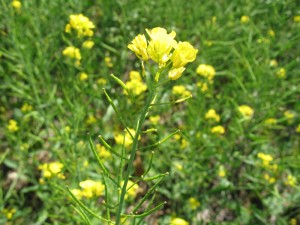Mustard is a broadleaf, cruciferous, cool-seasoned annual oilseed crop produced primarily for the condiment market. Two species and three types of mustards are grown in Western Canada: Sinapis alba (yellow mustard) and Brassica juncea (brown and oriental mustards). The different types of mustard vary in physical appearance (see how to distinguish mustard from canola) and use. In this document the term crucifers will be used to describe all plants in the Brassicaceae family (formerly Cruciferaceae family). The term brassica will be used to refer to plants in the genus Brassica.
Yellow mustard has a yellow seed coat and is primarily grown for the North American condiment industry, where it is used to produce traditional yellow mustard condiment, mayonnaise and certain salad dressings. The seed of yellow mustard also contains a water-binding mucilage that has been used as a binding agent and protein extender in prepared meats.
Brown and hybrid brown mustards have a reddish brown to dark brown seed coat while oriental mustard seeds are primarily yellow to dark yellow. Both brown and oriental mustards are used to create products that are spicier than yellow mustard condiments. Brown mustard is primarily exported to Europe where it is used to produce condiments and specialty mustards like Dijon mustard. Oriental mustard is primarily grown for export to Asian countries where it is used to produce condiments. Oriental mustard oil is used as a spicy cooking oil in some Asian countries, but is not consumed as an oil in North America.
A fourth type of mustard, Brassica carinata, commonly called “carinata” or “Ethiopian mustard,” has been grown in Saskatchewan; interest in this crop was primarily for bioplastic or biofuel industries. Due to changing markets, however, there has been little to no carinata production in the province for several years. This production manual therefore focuses on yellow, brown and oriental.
> Next: Plant Description: Growth stages

